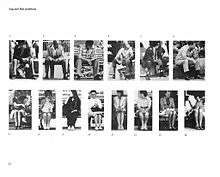Marianne Wex
| Marianne Wex | |
|---|---|
| Born |
13 July 1937 Hamburg, Germany |
| Nationality | German |
| Education | Hochschule für bildende Künste Hamburg |
| Alma mater | Hochschule für bildende Künste Hamburg |
| Notable work | "Let’s Take Back our Space”: ‘Female’ and ‘Male' Body Language[1] |
| Style | Conceptualism |
| Website |
www |
Marianne Wex (born 13 July 1937) is a German feminist photographer, author and self-healer.
Early life
Wex was born in Hamburg, Germany in 1937.[1]
Art

Wex began her artistic career as a painter. She eventually became interested in photography and body language. She started taking photographs around Hamburg.[2] Eventually, these photographs developed into a collection of over 3,000[2] and would develop into her most notable work: “Let’s Take Back our Space”: ‘Female’ and ‘Male’ Body Language. The work is a collection of over 5,000 photographs that display different and similar forms of male and female body language in public, including public art in her examples. She collected these images between 1972 and 1977.[3] The work, which was completed in 1979,[4] has been exhibited internationally, and a book was published under the same title. Originally published in German, the book has since been translated into English and French.[5] The work is cited as an important work in women's and gender studies, and feminist art.[5]
Wex's work has opened a dialogue on gender and body language and has inspired further works, such as a photographic series by Canadian artist Amelia Butler in 2003, depicting male and female customers posing in IKEA display rooms. These recent photographs show bodies that do not conform to the feminine and masculine norms that were established in Wex's work, and challenge the concepts brought up in her work.[6]
Wex taught art from 1963 until the 1980s.[1] However, after the completion of Let's Take Back Our Space, she was diagnosed with an illness that led to the end of her artistic career.[4]
Self-healing
After her diagnosis,[4] Wex left Germany, and eventually visited New Zealand. While there, she studied self-healing. She then traveled to London to study under Lily Cornford.[1] After studying with Cornford, Wex began teaching seminars and classes on self-healing to women. She continues this practice today.[2]
Bibliography
- Let's Take Back Our Space: Female and Male Body Language as a Result of Patriarchal Structures (Frauenliteratur Verlag, 1984, ISBN 3-923173-00-8, originally published as "Weibliche" und "männliche" Körpersprache als Folge patriarchalischer Machtverhältnisse in 1979)
- Parthenogenese Heute.Von der Urkraft der Frau aus sich selbst heraus zu gebären, ohne Beteiligung eines zweiten Geschlechtes (Verlag Anke Schäfer, Wiesbaden, 1992)
- "Menschliche Parthenogenese" in Lachesis, Fachzeitschrift des Berufsverbandes für Heilpraktikerinnen (2002)
Notable exhibitions
- 1977, Artists International 1877-1977, group show, Neue Gesellschaft für Bildende Kunst, Berlin, Germany
- 1979, Bonner Kunstverein, Bonn, Germany
- 1982, Institute of Contemporary Arts, London, England
- 2009, Focal Point Gallery, London, England[1]
- 2012, Badischer Kunstverein, Karlsruhe, Germany[4][7]
- 2012, Yale Union Laundry Building, Portland, Oregon
- 2013, Presentation House Gallery, Vancouver, British Columbia
References
- 1 2 3 4 5 "Let's Take Back Our Space". Exhibitions Archive. Focal Point Gallery. Retrieved 12 October 2014.
- 1 2 3 Sperlinger, Mike. "Two Slight Returns: Chauncey Hare and Marianne Wex". Afterall. Retrieved 12 October 2014.
- ↑ Company, David (Winter 2013). "Marianne Wex". Aperture. \ (213): 108-109.
- 1 2 3 4 Demircan, Saim. "Marianne Wex". Frieze. Retrieved 12 October 2014.
- 1 2 FrauenMediaTurm, Chronik der Neuen Frauenbewegung
- ↑ Cloke, Paul; Crang, Philip; Goodwin, Mark (December 5, 2013). Introducing Human Geographies, Third Edition. Taylor & Francis.
- ↑ "Marianne Wex at Badischer Kunstverein". Contemporary Art Daily.